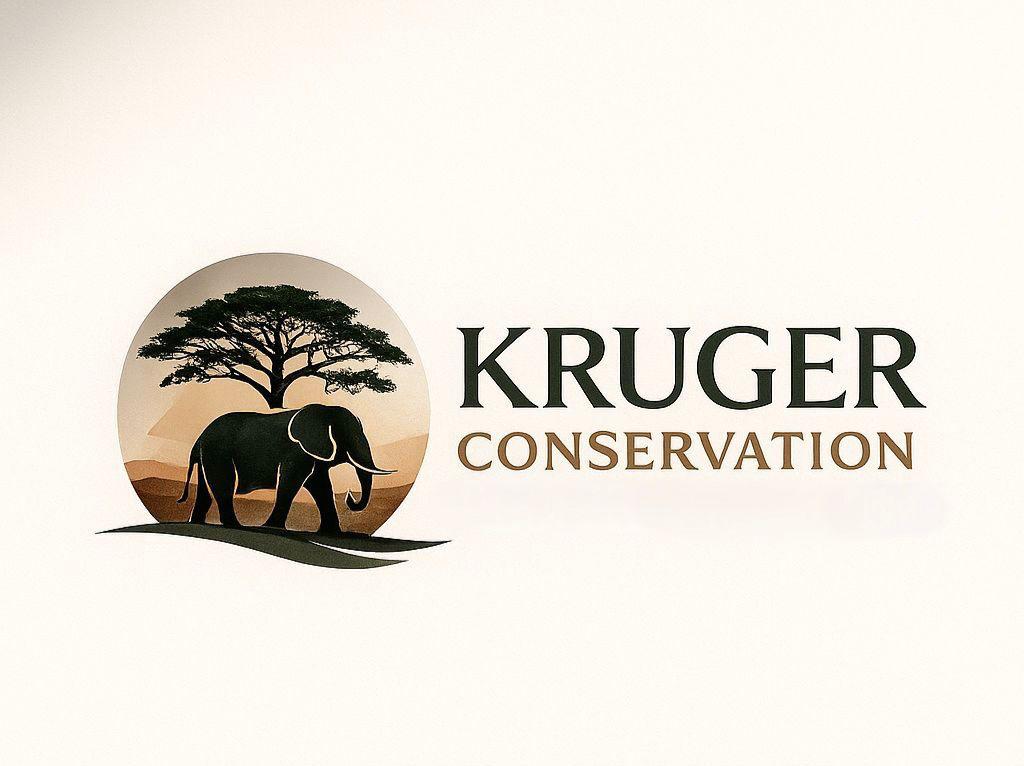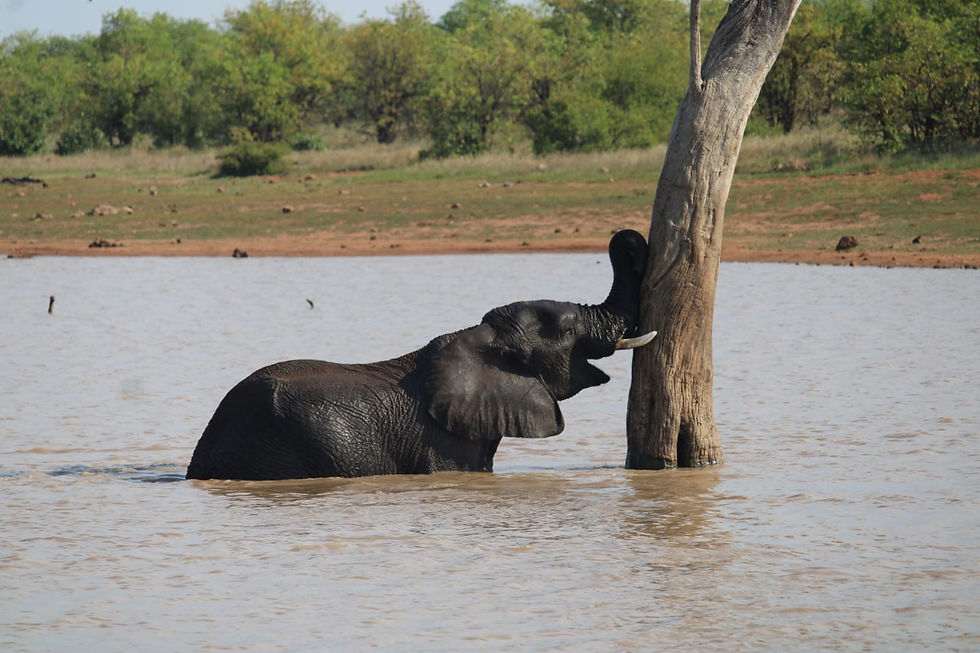Balancing Elephant: Conservation and Ecosystem Health
- krugerconservation

- Oct 15
- 7 min read
Updated: Oct 16
African elephants (Loxodonta africana) are not only the largest land animals on Earth but also
among the most intelligent and socially complex species. Living in matriarchal family groups, they
form intricate social networks characterized by empathy, cooperation, and long-term memory. The
oldest female, or matriarch, leads her herd to waterholes, feeding grounds, and safe route.
Knowledge often passed down over decades (McComb et al., 2001, Proc. R. Soc. B).
Elephants exhibit remarkable cognitive and emotional capacities. Playback experiments have shown
they can recognize the calls of over 100 different individuals, both relatives and non-relatives, even
over long distances (Poole et al., 2016, Nat. Commun.). They mourn their dead, protect their young
collectively, and communicate through low-frequency rumbles traveling several kilometers through
the ground (O’Connell-Rodwell et al., 2007, BioScience).
Male elephants play a crucial role as well. Mature bulls (particularly over 30 years old) moderate the behavior of younger males, reduce aggression, and maintain hierarchy within bachelor groups.
When older bulls are absent, younger males are more prone to prolonged musth and display dangerous behavior toward other animals and humans (Slotow et al., 2000, Nature).
As primatologist Jane Goodall famously said,
“Elephants are the architects of the savannah. Without them, the ecosystem would collapse.”
Their feeding and tree-felling behavior shape landscapes, create habitats for smaller species, and open pathways for countless others. They are ecosystem engineers in every sense (Haynes, 2012, Ecology and Evolution).
From Victims of Poaching to Overpopulation
Throughout the 20th century, elephants were decimated by the ivory trade. Between the 1970s and
1980s, Africa’s elephant population declined by over 50%, with approximately 700,000 individuals
lost to poaching (UNEP & CITES, 2013). Thanks to stronger anti-poaching laws, and the creation of protected areas, populations in many regions have recovered.
Today, some parks face a different challenge: overpopulation. In Kruger (South Africa) and Chobe
(Botswana), elephant densities have surpassed the ecological carrying capacity. The consequences
are clear: trees are toppled, vegetation structure is altered, and plant diversity declines, affecting
birds, insects, and other herbivores (Kerley et al., 2008, Biol. Conserv.).
Large herds compact soil, erode landscapes, and overuse water sources, reducing ecosystem
resilience. Overpopulated herds may enter agricultural zones, destroying crops and threatening
livelihoods (Hoare, 2015, Oryx). Overpopulation also raises health and behavioral risks: increased
competition for limited food weakens immune systems, fosters disease transmission, and elevates
stress, measurable through cortisol levels (Gobush et al., 2008, Anim. Conserv.).
Dr. Paula Kahumbu emphasizes the moral dimension:
“We must consider elephants as part of our family. Their welfare is our welfare”
(Kahumbu, 2022,WildlifeDirect).
Relocations and Their Limits
Translocation (the capture and movement of elephants to less populated areas) has been used for
decades as a non-lethal management tool. In theory, it redistributes populations and reduces local
ecological pressure. However, in practice, it faces severe limitations.
Elephants possess extraordinary spatial memory and are known to return over hundreds of
kilometers to their original home ranges, even years after relocation (Fernando et al., 2008,
Biological Conservation). This homing instinct renders many translocation efforts temporary or
ineffective.
The process itself is logistically complex and extremely costly. Transporting a single family group
can cost tens of thousands of dollars and requires heavy machinery, veterinary supervision, and
aerial support (IUCN African Elephant Specialist Group, 2020). Moreover, it is stressful for the
animals: elevated heart rates, dehydration, and injury risks are common, particularly for calves
separated from their mothers during capture (Pinter-Wollman, 2009, Animal Behaviour).
Additionally, relocated elephants can disrupt social hierarchies in the recipient populations, leading
to conflicts with resident herds. In cases where animals are moved to smaller reserves, the new
ecosystems can also suffer from overbrowsing or competition with existing wildlife (Hoare & du
Toit, 1999, Oryx Journal).
Culling, Natural Mortality, and the Role of Trophy Hunting
Culling, the targeted killing of elephants, is currently being used again in Kruger National Park and
other protected areas in South Africa as a management tool to stabilize the balance between
vegetation, biodiversity, and elephant populations (South African National Parks, 2024).

Earlier culling programs primarily targeted older elephants, typically between 20 and 35 years old,
under the assumption that their removal would have minimal impact on social structures. However, eliminating experienced matriarchs caused significant disruptions: these older elephants hold intergenerational knowledge of water sources, migration routes, and danger zones, serving as essential social anchors. Their removal profoundly affects the survival, orientation, and cohesion of entire herds (Bangor University, 2025). Even beyond this, culling undermines complex social
networks and learning processes. Young bulls growing up without older male role models often
develop abnormal dominance behaviors. Without experienced elephants to guide and regulate them,
these young males exhibit exaggerated aggression; similar to children raised without parental
guidance. Such individuals, commonly referred to as “naughty elephants,” have demonstrated
increased aggression toward both humans and other elephants.
Natural Mortality and the Lack of Predators
Adult elephants have virtually no natural predators; only weakened or very young individuals are
occasionally preyed upon by lions or hyenas. Most elephants die from drought, malnutrition, or
water scarcity, especially during periods of climatic extremes. Studies show that during dry periods,

elephants frequently die from exhaustion, dehydration, or age-related tooth wear that impedes feeding (Douglas-Hamilton et al., 2005, Biol. Conserv.; Moss, 2011).
With increasing droughts due to climate change, this slow starvation becomes a severe animal
welfare issue. In dense populations, culling or regulated hunting can sometimes be considered a means to prevent such prolonged suffering (Joubert, 2007).
Controlled Trophy Hunting as a Potential Alternative
In recent years, controlled trophy hunting has been discussed as a potentially more sustainable
alternative to large-scale culling. Under scientific oversight and clear ethical standards, it can create
economic incentives, secure habitats, and selectively remove older, non-reproductive bulls
(Zimbabwe Parks and Wildlife Management Authority, 2022).
One major advantage lies in the economic aspect: trophy hunting can generate substantial revenue
that supports protected areas, anti-poaching programs, and local development projects. In Namibia,
for example, the Conservancy model channels a significant portion of hunting revenue directly to
local communities, funding schools, wells, and ranger positions. This community-based use of
wildlife has proven effective in actively involving local populations in conservation (Naidoo et al.,
2016, Biol. Conserv.).

Another positive aspect is the incentive to preserve habitats. Studies show that in regions where legal, regulated hunting is permitted, wildlife populations remain stable or even increase, while comparable areas without economic use often experience higher poaching rates (Lindsey et al., 2007, Biol. Conserv.).
By generating revenue from wildlife, hunting areas create a financial reason to maintain large, contiguous landscapes rather than converting them into farmland.
Additionally, selective hunting of individual older bulls can help reduce human–elephant conflicts. In high-density populations, elephants often destroy crops or enter villages. By targeting problem individuals and directing the revenue to affected communities, local acceptance of elephant conservation increases (Dickman et al., 2019, Conserv. Biol.).
Scientifically managed hunting programs emphasize selectivity: only older bulls, typically over 40
years old and past their reproductive phase, are removed (Campfire Data Summary, 2022). This
approach contrasts sharply with poaching, which usually targets young, reproductive animals. With
clear quotas, transparent management, and independent oversight, trophy hunting can become part
of an integrated population management strategy that balances ecological and social factors
(Lindsey et al., 2020, PLOS ONE).
Culling versus Hunting – A Comparison
In direct comparison, culling can quickly reduce population numbers but has profound negative
effects on social structures and learning processes within herds, leaving long-term disturbances
measurable decades later (Shannon et al., 2013). Regulated trophy hunting, in contrast, is selective,
generally affects only individual animals, and, when conducted under strict ecological guidelines,
can help financially stabilize protected areas and strengthen community support (Naidoo et al.,
2016; Lindsey et al., 2007).
Hormonal Contraception – A Scientifically Justified Management Tool
Hormonal contraception is increasingly recognized as a scientifically supported and ethically
defensible method to regulate elephant populations while maintaining social cohesion. This strategy
uses hormonal implants or immunocontraceptive vaccines to temporarily suppress ovulation in
females or spermatogenesis in bulls. Unlike domestic species, surgical sterilization in elephants is
technically extremely difficult, high-risk, and stressful, making hormonal methods the most
practical and minimally invasive alternative (East, 2009, Journal of Wildlife Management).
While contraception in bulls has been successfully implemented in several conservation projects,
studies and long-term experience with female elephants remain limited. Further research is needed
to understand potential effects on fertility cycles, stress physiology, and social dynamics, and to
develop protocols that minimize disturbance and health risks (Pienaar et al., 2019, Animal
Reproduction Science).
Implementing hormonal contraception is logistically complex and costly. Each procedure requires
immobilization with tranquilizers, veterinary supervision, repeated administration, and careful
monitoring to maintain efficacy (Keeley et al., 2015, Journal of Wildlife Diseases). Costs per animal
can reach tens of thousands of dollars annually, depending on herd size, accessibility, and delivery
method. Despite these challenges, the method allows populations to be managed without destroying natural social structures or causing unnecessary animal suffering.
Maintaining Ecological Balance
Elephants are the builders of the savannah, shaping vegetation, creating habitats for other species,
and promoting biodiversity through their feeding, trampling, and tree-felling activities (Haynes,
2012, Ecology and Evolution). However, overpopulation can disrupt these ecological functions.
When elephant densities exceed the ecological carrying capacity, vegetation degradation, soil
compaction, and loss of plant diversity can occur, negatively affecting other wildlife and ecosystem
services (Kerley et al., 2008, Biological Conservation).

Studies suggest that an ideal elephant population density is roughly 1 elephant per 1,000 hectares,
which allows elephants to fulfill their ecological role without causing long-term habitat damage
(Chase et al., 2016, Biological Conservation). In this context, targeted hormonal contraception is ahigh-investment but high-value tool that balances elephant welfare,
social integrity, and ecosystem preservation.
Our Work at Kruger Conservation
At Kruger Conservation, we are dedicated to protecting Africa’s elephants while maintaining the
delicate balance of their ecosystems. One of our key initiatives is the use of hormonal contraception
for selected bulls in the Greater Kruger region.
By temporarily regulating reproductive capacity, this


Comments